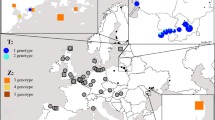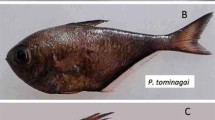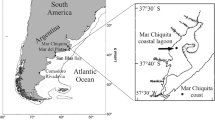Abstract
Open-coast and deep-water ecosystems have been less disrupted by invasion than estuaries, but a notable exception is the establishment of multiple species of the sea slug genus Philine in the northeastern Pacific. These large slugs spread from San Francisco Bay to the whole of the US west coast in 5 years during the 1990s, and are abundant from intertidal mudflats to soft-sediment bottoms >300 m deep along the open coast. Voracious predators that secrete acid, Philine spp. have few natural enemies and substantial impacts on native bivalve communities. Despite their ecological significance, the identity and number of invasive Philine spp. in the US has remained controversial. Here, we adopt a molecular approach to identify the species commonly found along the US west coast. We compared mitochondrial 16S gene sequences of reference specimens from the native range of seven possible invaders against sequences of 66 specimens collected from southern California to Oregon from intertidal and subtidal habitats. All slugs from southern California and Oregon were confirmed as P. auriformis, and most shared haplotypes with samples from New Zealand. Larger slugs from San Francisco, Tomales Bay and Bodega Harbor, believed to represent 3–4 species, were all identified as P. orientalis. Molecular data support a recent morphological analysis that erected two proposed species, P. paucipapillata from Hong Kong and P. quadripartita from Europe, which are genetically distinct from anatomically similar species. For taxonomically challenging groups like sea slugs, genetic data can illuminate cryptic invasions and provide a backdrop for further studies of the ecological impacts of introduced marine species.



Similar content being viewed by others
References
Andreakis N, Procaccini G, Maggs C, Kooistra W (2007) Phylogeography of the invasive seaweed Asparagopsis (Bonnemaisoniales, Rhodophyta) reveals cryptic diversity. Mol Ecol 16:2285–2299
Anthes N, Schulenburg H, Michiels NK (2008) Evolutionary links between reproductive morphology, ecology and mating behavior in opisthobranch gastropods. Evolution 62:900–916
Armstrong KF, Ball SL (2005) DNA barcodes for biosecurity: invasive species identification. Phil Trans Roy Soc B 360:1813–1823
Asif JH, Krug PJ (2011) Lineage distribution and barriers to gene flow among populations of the globally invasive marine mussel Musculista senhousia. Biol Invasions. doi:10.1007/s10530-011-0169-6
Bastrop R, Blank M (2006) Multiple invasions: a polychaete genus enters the Baltic Sea. Biol Inv 8:1195–1200
Bax N, Carlton JT, Mathews-Amos A, Haedrich RL, Howarth FG, Purcell JE, Rieser A, Gray A (2001) The control of biological invasions in the world’s oceans. Conserv Biol 15:1234–1246
Behrens DW (1991) Pacific coast nudibranchs, 2nd edn. Sea Challengers, Monterey
Behrens DW (2004) Pacific coast nudibranchs, supplement II. Proc Cal Acad Sci 55:11–54
Cadien DB, Ranasinghe JA (2003) Invaders in the open sea: establishment of the New Zealand snail Philine auriformis in southern California coastal waters. In Weisberg SB, Elmore D (eds) Annual report of the Southern California coastal water research project, Westminster, pp 253–265
Carlton JT (1979) History, biogeography, and ecology of the introduced marine and estuarine invertebrates of the Pacific coast of North America. Ph.D. dissertation, UC Davis
Carlton JT (1996a) Biological invasions and cryptogenic species. Ecology 77:1653–1655
Carlton JT (1996b) Pattern, process, and prediction in marine invasion ecology. Biol Conserv 78:97–106
Chow MM (2001) Ecological impacts of introduced opisthobranchs, Philine spp., on the Bodega Harbor mudflats. M.S. thesis, San Francisco State University
Clement M, Posada D, Crandall KA (2000) TCS: a computer program to estimate gene genealogies. Mol Ecol 9:1657–1659
Cohen AN, Carlton JT (1995) Non-indigenous aquatic species in a United States estuary; a case study of the biological invasions of the San Francisco Bay and Delta. United States Fish and Wildlife Service, Washington
Cohen AN, Carlton JT (1998) Accelerating invasion rate in a highly invaded estuary. Science 279:555–558
Darling JA, Blum MJ (2007) DNA-based methods for monitoring invasive species: a review and prospectus. Biol Inv 9:751–765
Deagle BE, Bax N, Patil JG (2003) Development and evaluation of a PCR-based test for detection of Asterias (Echinodermata: Asteroidea) larvae in Australian plankton samples from ballast water. Mar Freshwater Res 54:709–719
DeSalle R, Egan MG, Siddall M (2005) The unholy trinity: taxonomy, species delimitation and DNA barcoding. Phil Trans Roy Soc Lond Ser B 360:1905–1916
Douady CJ, Delsuc F, Boucher Y, Doolittle WF, Douzery JP (2003) Comparison of Bayesian and maximum likelihood bootstrap measures of phylogenetic reliability. Mol Biol Evol 20:248–254
Ellingson RA, Krug PJ (2006) Evolution of poecilogony from planktotrophy: cryptic speciation, phylogeography, and larval development in the gastropod genus Alderia. Evolution 60:2293–2310
Excoffier L, Lischer HE (2010) Arlequin suite ver 3.5: a new series of programs to perform population genetics analyses under Linux and Windows. Mol Ecol Res 10:564–567
Galtier N, Depaulis F, Barton NH (2000) Detecting bottlenecks and selective sweeps from DNA sequence polymorphism. Genetics 155:981–987
Geller JB (1999) Decline of a native mussel masked by sibling species invasion. Conserv Biol 13:661–664
Geller JB, Walton ED, Grosholz ED, Ruiz GM (1997) Cryptic invasions of the crab Carcinus detected by molecular phylogeography. Mol Ecol 6:901–906
Gibson GD, Chia F-S (1989) Description of a new species of Haminoea, Haminoea callidegenita (Mollusca: Opisthobranchia), with a comparison with two other Haminoea species found in the northeast Pacific. Can J Zool 67:914–922
Goddard J (1998) Philine in Oregon (http://www.seaslugforum.net/find/217)
Gosliner TM (1995) Introduction and spread of Philine auriformis (Gastropoda: Opisthobranchia) from New Zealand to San Francisco Bay and Bodega Harbor. Mar Biol 122:249–255
Gosliner TM (1998) A third Philine in California (http://www.seaslugforum.net/find/230)
Gosliner TM, Behrens DW (2006) Anatomy of an invasion: systematics and distribution of the introduced opisthobranch snail, Haminoea japonica Pilsbry, 1895 (Gastropoda: Opisthobranchia: Haminoeidae). Proc Cal Acad Sci 57:1003–1010
Grande C, Templado J, Cervera JL, Zardoya R (2004) Molecular phylogeny of Euthyneura (Mollusca: Gastropoda). Mol Biol Evol 21:303–313
Grosholz ED (2002) Ecological and evolutionary consequences of coastal invasions. Trends Ecol Evol 17:22–27
Hanfling B, Carvalho GR, Brandl R (2002) mtDNA sequences and possible invasion pathways of the Chinese mitten crab. Mar Ecol Prog Ser 238:307–310
Hirano YJ, Hirano YM (1991) Poecilogony or cryptic species? Two geographically different development patterns observed in ‘Cuthona pupillae (Baba, 1961)’ (Nudibranchia: Aeolidoidea). J Molluscan Stud 57:133–141
Holland BS (2000) Genetics of marine bioinvasions. Hydrobiologia 420:63–71
Holland BS, Dawson MN, Crow GL, Hofmann DK (2004) Global phylogeography of Cassiopea (Scyphozoa: Rhizostomeae): molecular evidence for cryptic species and multiple invasions of the Hawaiian Islands. Mar Biol 145:1119–1128
Huelsenbeck JP, Rannala B (2004) Frequentist properties of Bayesian posterior probabilities of phylogenetic trees under simple and complex substitution models. Syst Biol 53:904–913
Jensen KR (1993) Morphological adaptations and plasticity of radular teeth of the Sacoglossa (= Ascoglossa) (Mollusca: Opisthobranchia) in relation to their food plants. Biol J Linn Soc 48:135–155
Krug PJ, Ellingson RA, Burton RA, Valdés Á (2007) A new poecilogonous species of sea slug (Opisthobranchia: Sacoglossa) from California: comparison with the planktotrophic congener Alderia modesta (Lovén, 1844). J Molluscan Stud 73:29–38
Krug PJ, Morley MS, Asif JH, Hellyar LL, Blom WM (2008) Molecular confirmation of species status for the rare cephalaspidean Melanochlamys lorrainae (Rudman, 1968), and comparison with its sister species M. cylindrica Cheeseman, 1881. J Molluscan Stud 74:267–276
Krug PJ, Händeler K, Vendetti JE (2012) Genes, morphology, development and photosynthetic ability support the resurrection of Elysia cornigera (Heterobranchia: Plakobranchoidea) as distinct from the solar-powered sea slug E. timida. Invert Syst (in press)
Lavoie DM, Smith LD, Ruiz GM (1999) The potential for intracoastal transfer of non-indigenous species in the ballast water of ships. Est Coast Shelf Sci 48:551–564
Lindholm AK, Breden F, Alexander HJ, Chan W-K, Thakurta SG, Brooks R (2005) Invasion success and genetic diversity of introduced populations of guppies Poecilia reticulata in Australia. Mol Ecol 14:3671–3682
Lydeard C, Holznagel WE, Schnare MN, Gutell RR (2000) Phylogenetic analysis of molluscan mitochondrial LSU rDNA sequences and secondary structures. Mol Phylog Evol 15:83–102
Martel C, Viard F, Bourguet D, Garcia-Meunier P (2004) Invasion by the marine gastropod Ocinebrellus inornatus in France I. Scenario for the source of introduction. J Exp Mar Biol Ecol 305:155–170
McDonald JH, Koehn RK (1988) The mussels Mytilus galloprovincialis and M. trossulus on the Pacific coast of North America. Mar Biol 99:111–118
Medina M, Walsh PJ (2000) Molecular systematics of the order Anaspidea based on mitochondrial DNA sequence (12S, 16S, and COI). Mol Phylog Evol 15:41–58
Meyer CP, Paulay G (2005) DNA barcoding: error rates based on comprehensive sampling. PLoS Biol 3:e422. doi:10.1371/journal.pbio.0030422
Morrow C, Thorpe J, Picton B (1992) Genetic divergence and cryptic speciation in two morphs of the common subtidal nudibranch Doto coronata (Opisthobranchia: Dendronotacea: Dotoidae) from the northern Irish Sea. Mar Ecol Prog Ser 84:53–61
Pagel M, Meade A (2004) A phylogenetic mixture model for detecting pattern-heterogeneity in gene sequence or character-state data. Syst Biol 53:571–581
Palumbi SR (1996) Nucleic acids II: the polymerase chain reaction. In: Hillis D, Moritz C, Mable B (eds) Molecular systematics. Sinauer, Sunderland, pp 205–247
Pimentel D, Lach L, Zuniga R, Morrison D (2000) Environmental and economic costs of nonindigenous species in the United States. Bioscience 50:53–65
Posada D (2004) Collapse ver. 1.2. Available from http://darwin.uvigo.es
Price RM, Gosliner TM, Valdés A (2011) Systematics and phylogeny of Philine (Gastropoda: Opisthobranchia), with emphasis on the Philine aperta species complex. Veliger 51:1–58
Ranasinghe JA, Mikel TK, Velarde RG, Weisberg SB, Montagne DE, Cadien DB, Dalkey A (2005) The prevalence of non-indigenous species in southern California embayments and their effects on benthic macroinvertebrate communities. Biol Inv 7:679–686
Rogers AR, Harpending H (1992) Population growth makes waves in the distribution of pairwise genetic differences. Mol Biol Evol 9:552–569
Roman J (2006) Diluting the founder effect: cryptic invasions expand a marine invader’s range. Proc R Soc B 273:2453–2459
Rudman WB (1972) The genus Philine (Opisthobranchia, Gastropoda). Proc Malac Soc Lond 40:171–187
Rudman WB (1998) Comment on the identity of Californian Philine auriformis. (http://www.seaslugforum.net/find/200)
Ruiz GM, Fofonoff PW, Carlton JT, Wonham MJ, Hines AH (2000) Invasions of coastal marine communities in North America: apparent patterns, processes, and biases. Ann Rev Ecol Syst 31:481–531
Saunders GW (2007) Routine DNA barcoding of Canadian Gracilariales (Rhodophyta) reveals the invasive species Gracilaria vermiculophylla in British Columbia. Mol Ecol Res 9:S140–S150
See KE, Feist BE (2010) Reconstructing the range expansion and subsequent invasion of introduced European green crab along the west coast of the United States. Biol Inv 12:1305–1318
Simmons MP, Pickett KM, Miya M (2004) How meaningful are Bayesian support values? Mol Biol Evol 21:188–199
Sisson CG (2002) Dichotomous life history patterns for the nudibranch Dendronotus frondosus (Ascanius, 1774) in the Gulf of Maine. Veliger 45:290–298
Stepien CA, Tumeo MA (2006) Invasion genetics of Ponto-Caspian gobies in the Great Lakes: a ‘cryptic’ species, absence of founder effects, and comparative risk analysis. Biol Invasions 8:61–78
Strub PT, James C (2000) Altimeter-derived variability of surface velocities in the California Current System: 2. Seasonal circulation and eddy statistics. Deep-Sea Res II 47:831–870
Suter HH (1909) Descriptions of new species and subspecies of New Zealand Mollusca, with notes on a few species. Proc Malacol Soc 8:253–265
Tamura K, Peterson D, Peterson N, Stecher G, Nei M, Kumar S (2011) MEGA5: Molecular evolutionary genetics analysis using maximum likelihood, evolutionary distance, and maximum parsimony methods. Mol Biol Evol. doi:10.1093/molbev/msr121
Thompson JD, Gibson TJ, Plewniak F, Jeanmougin F, Higgins DG (1997) The ClustalX windows interface: flexible strategies for multiple sequence alignment aided by quality analysis tools. Nucleic Acid Res 24:4876–4882
Trowbridge CT (1997) Dietary induction of opisthobranch morphology: Placida dendritica (Alder & Hancock, 1843) on different green algal hosts. J Molluscan Stud 63:29–38
Turner LM, Wilson NG (2007) Polyphyly across oceans: a molecular phylogeny of the Chromodorididae (Mollusca, Nudibranchia). Zool Scripta 37:23–42
Valdés Á (2003) Preliminary molecular phylogeny of the radula-less dorids (Gastropoda: Opisthobranchia), based on 16S mtDNA sequence data. J Molluscan Stud 69:75–80
Voisin M, Engel CR, Viard F (2005) Differential shuffling of native genetic diversity across introduced regions in a brown alga: aquaculture vs. maritime traffic effects. Proc Natl Acad Sci 102:5432–5437
Acknowledgments
We thank R. Willan, B. Pernet, Y. Ralph, H. Weiskel and J. Goddard for collecting and sharing specimens, R. Portela Miguez for assistance with loaned material from the Natural History Museum of London, and C. Stepien and an anonymous reviewer for suggestions that greatly improved the manuscript. This study was supported by awards to PJK from the US National Science Foundation (OCE 06-48606 and 11-30072, DEB 08-17084), a faculty-student collaborative grant from the California State University Program for Education and Research in Biotechnology (CSUPERB), and an NSF GK-12 fellowship to J. Asif.
Author information
Authors and Affiliations
Corresponding author
Electronic supplementary material
Below is the link to the electronic supplementary material.
Rights and permissions
About this article
Cite this article
Krug, P.J., Asif, J.H., Baeza, I. et al. Molecular identification of two species of the carnivorous sea slug Philine, invaders of the US west coast. Biol Invasions 14, 2447–2459 (2012). https://doi.org/10.1007/s10530-012-0242-9
Received:
Accepted:
Published:
Issue Date:
DOI: https://doi.org/10.1007/s10530-012-0242-9




